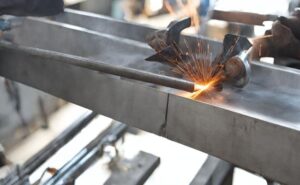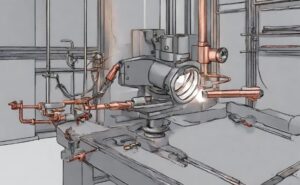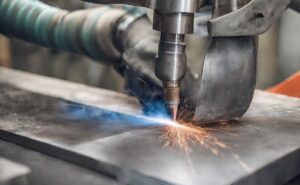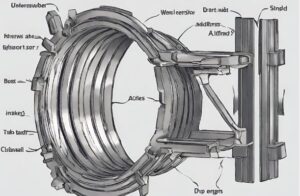Table of Contents
Welcome to the world of welding, where precision meets skill. Understanding undercut in welding is crucial to achieving impeccable welds. In this article, we’ll delve into the depths of undercut: its definition, causes, prevention, and techniques. Discover how mastering this aspect can elevate your welding prowess and ensure impeccable results. Let’s explore the intricacies together!
1. What is Undercut in welding?
Undercut in welding refers to a groove or recess formed along the weld toe or weld face, reducing the cross-sectional thickness of the base material at the joint. It’s characterized by a concave area near the weld’s toe, and if left unaddressed, it can compromise the structural integrity of the weld joint.
Exploring Types of Undercut
- External Undercut: This occurs on the external surface of the weld joint and is visible and easily detectable.
- Internal Undercut: Found within the welded joint, challenging to detect without inspection.
Significance and Dangers of Undercutting
Understanding its significance lies in recognizing its detrimental impact. Undercutting weakens the weld, making it prone to cracks, corrosion, and even structural failure. It compromises the load-bearing capacity of the weld joint, making it crucial to detect and prevent.
Detection methods such as visual inspection, ultrasonic testing, or magnetic particle inspection are essential for identifying and addressing undercuts and ensuring weld integrity.
Undercutting is not merely a cosmetic flaw but a structural concern that demands attention to ensure welded components retain their strength and durability.
The exploration of these facets of undercutting provides the foundational understanding necessary to comprehend its causes and preventive measures in the welding process.
2. Causes of Undercut
Overview of Undercutting Factors
Understanding the causes of undercutting is pivotal in implementing effective preventive measures. Several factors contribute to the formation of undercut in welding processes:
Primary Causes
- Incorrect welding parameters:
High Current: Excessive amperage leads to increased heat, potentially melting away excess material.
High Travel Speed: Rapid movement of the welding torch can create insufficient deposition of filler metal.
High Arc Voltage: Increased voltage can cause irregular melting patterns, leading to undercut formation.
- Electrode and Shielding Issues:
Improper Electrode Material: Incompatible electrode material can result in inconsistent melting and deposition.
Electrode Angle and Size: An incorrect angle or size affects heat distribution and filler metal deposition.
Wrong Shielding Gas: Inadequate or contaminated gas disrupts the weld pool, leading to irregularities.
- Wrong welding techniques:
Weaving Technique: Improper weaving patterns can create irregular fusion and insufficient coverage.
Excessive Arc Length: Prolonged arc length contributes to insufficient heat input, affecting weld penetration.
Lack of Edge Preparation: Inadequate preparation of joint edges results in poor weld fusion.
In-depth Analysis of Undercutting Causes
- Speed of Electrode Movement:
Rapid movement of the electrode can result in inadequate deposition of filler material, leading to a weakened joint.
- Heat Generation:
Excessive heat, if not properly controlled, melts away excess material, creating grooves or recesses along the weld and weakening its structural integrity.
- Poor welding technique:
Inadequate welding practices, such as improper weaving or erratic movements, contribute to irregular melting patterns and insufficient coverage, facilitating undercut.
- Arc Length and Electrode Details:
Prolonged arc length or incorrect electrode specifications affect heat input and material deposition, resulting in incomplete fusion and undercut.
- Shielding Gas and Filler Material:
Contaminated or improper shielding gas disrupts the protective atmosphere, leading to oxidation and irregular weld pool behavior, causing undercut.
- Surface Quality of Parent Material:
An inadequately prepared base material surface, such as the presence of contaminants or poor surface conditions, affects weld fusion and contributes to undercut formation.
Understanding the intricacies of each cause allows welders to address them meticulously. Identifying and rectifying these factors, whether related to parameters, techniques, or materials, forms the basis for effective undercut prevention and high-quality welds.
Addressing Undercutting Factors
Understanding these causes is the first step toward effective prevention and resolution. Welders must adopt a proactive approach that involves:
- Parameter Optimization:
Balancing current, travel speed, and arc voltage within recommended ranges to regulate heat input and metal deposition.
- Correct Electrode and Shielding Practices:
Employing suitable electrode materials, angles, sizes, and compatible shielding gases to ensure uniform fusion and adequate penetration.
- Refinement of Welding Techniques:
Practicing appropriate weaving methods, maintaining optimal arc length, and ensuring meticulous edge preparation for consistent, strong welds.
- Controlled Electrode Movement:
Managing electrode speed to facilitate proper filler metal deposition without creating surface irregularities.
- Heat Regulation:
Monitoring and regulating heat generation to prevent excessive base material melting reduces the risk of undercut formation.
- Enhanced Surface Preparation:
Preparing base materials meticulously to ensure clean, defect-free surfaces promotes better fusion and reduces the likelihood of undercutting.
By addressing these causes systematically, welders can minimize or eliminate the occurrence of undercut, ensuring high-quality, durable welds. It’s this attention to detail and precision that distinguishes exceptional welding practices from the rest.
Application of Preventive Measures
- Continuous Monitoring and Adjustment:
Regularly monitoring welding parameters during operations and making real-time adjustments to maintain optimal settings.
- Training and skill development:
Providing comprehensive training to welders on proper techniques, material understanding, and equipment handling will enhance their ability to prevent and rectify undercutting issues.
- Quality Control and Inspection:
Implementing stringent quality control measures, including visual inspections and non-destructive testing, to detect and address undercutting at its early stages.
- Documentation and Analysis:
Keeping detailed records of welding procedures and outcomes to analyze trends and patterns allows for targeted improvements and preventive actions.
- Collaboration and Knowledge Sharing:
Fostering an environment of collaboration among welders, engineers, and supervisors to share experiences, best practices, and lessons learned in preventing undercutting.
- Technological Integration:
Embracing technological advancements, such as automated monitoring systems, will augment human oversight and ensure adherence to optimal welding parameters.
These proactive measures, coupled with a culture of continuous improvement and knowledge exchange, empower welders and organizations to effectively combat undercutting challenges. Through a comprehensive approach that encompasses training, technology, and stringent quality control, the welding industry can consistently produce high-quality, reliable welds while minimizing the occurrence of undercut.
3. Prevention and Remedies
Quick Tips for Prevention
- Electrode Angle and Size: Maintaining a 30-45 degree angle and using the appropriate electrode size ensures proper heat distribution and filler metal deposition.
- Regulating Travel Speed and Arc Length: Balancing speed and maintaining an optimal arc length ensure adequate weld penetration and coverage.
- Proper Shielding Gas and Clean Surface: Using pure and compatible shielding gas along with a clean, well-prepared surface prevents irregularities in the weld pool.
- Correct Welding Technique: Employing proper weaving patterns and ensuring adequate edge preparation promotes uniform fusion and weld strength.
Specific Remedies for Undercutting
- Electrode Angle and Size Adjustment: Adhering to recommended angles and electrode sizes minimizes irregular melting and deposition.
- Regulating Travel Speed and Arc Length: Balancing speed with arc length prevents inadequate heat input and incomplete fusion.
- Proper Shielding Gas and Surface Preparation: Utilizing appropriate shielding gas and ensuring a clean surface enhances weld quality and mitigates irregularities.
- Correct Welding Technique Application: Practicing proper weaving techniques and thorough edge preparation ensures uniform fusion and reduces the likelihood of undercut formation.
Implementing these preventive measures and specific remedies involves a comprehensive understanding of the welding process and a meticulous approach to adjusting parameters and techniques. By addressing these aspects, welders can significantly reduce undercutting and produce stronger, more durable welds.
4. Undercut Welding Techniques
Understanding Undercut Welding
Undercut welding encompasses various techniques aimed at managing and mitigating undercut formation. It involves strategies that manipulate welding parameters, equipment, and welding methods to minimize or eliminate undercuts.
Variations and Options Available
- Different Options: Undercut welding techniques include variations like pulsing current, adjusting travel speed, and altering shielding gas flow rates.
- Customized Approaches: Techniques vary based on material type, joint configuration, and welding positions.
How Undercut Welding Works
- Principles: Undercut welding aims to regulate heat input, filler metal deposition, and shielding gas flow to achieve consistent and controlled weld profiles.
- Equipment Required: Specialized welding machines, torches, and sometimes specific consumables may be necessary for optimal undercut welding.
Advantages and Drawbacks
- Advantages: Undercut welding, when executed correctly, results in stronger joints with an improved aesthetic appearance.
- Drawbacks: Improper application or execution of undercut welding techniques can exacerbate undercutting issues or compromise weld integrity.
What Can and Can’t be Welded using Undercut Techniques
- Feasible Applications: Undercut welding is suitable for various materials and joint configurations.
- Limitations: Some intricate joints or materials with specific requirements might not be ideal for undercut welding techniques.
1. Implementation of Undercut Welding Techniques
- Adaptation to Material and Joint Requirements:
Tailoring undercut welding techniques to suit the specific characteristics of the material being welded and the joint configuration enhances the effectiveness of the welding process.
- Precision in Parameter Adjustment:
Fine-tuning welding parameters, such as current pulsing frequency, travel speed, and shielding gas flow rates, ensures optimal conditions for controlled fusion and deposition.
- Specialized Equipment Utilization:
Employing specialized welding machines, torches, and consumables designed for undercut welding enhances precision and promotes consistent results.
- Experimental Validation and Refinement:
Conducting trial welds and iterative adjustments based on outcomes helps refine the application of undercut welding techniques for specific scenarios.
- Documentation of Best Practices:
Maintaining a repository of successful practices, including parameter configurations and equipment settings, aids in establishing standardized procedures for future reference.
- Continuous Training and Skill Enhancement:
Providing ongoing training to welders on the latest advancements and techniques in undercut welding fosters skill development and promotes proficiency.
By integrating these approaches, welders can not only mitigate undercutting challenges but also harness the potential of undercut welding techniques to create robust and aesthetically pleasing welds. This amalgamation of precision, adaptability, and continual improvement ensures the efficacy of undercut welding in diverse welding applications.
2. Refinement and Optimization
- Continuous Process Improvement:
Encouraging a culture of continuous improvement allows for the identification of bottlenecks and inefficiencies in undercut welding techniques, leading to their refinement.
- Feedback Incorporation:
Gathering feedback from welders, engineers, and quality control personnel regarding the effectiveness and practicality of employed techniques aids in iterative enhancements.
- Technological Integration for Precision:
Embracing technological advancements, such as automated monitoring systems or predictive analytics, augments the precision and efficiency of undercut welding practices.
Collaborative Knowledge Exchange
- Interdisciplinary Collaboration:
Facilitating collaboration among welding experts, material scientists, and equipment manufacturers fosters the exchange of insights, resulting in innovative solutions for undercut mitigation.
- Industry Standards and Best Practices:
Contributing to and adopting industry standards and best practices related to undercut welding techniques ensures consistency and quality across welding processes.
Validation and Application
- Validation through testing and validation:
Subjecting the refined undercut welding techniques to rigorous testing and validation procedures ensures their reliability and effectiveness across a spectrum of welding scenarios.
- Real-world Application and Case Studies:
Applying these refined techniques to real-world welding projects and documenting their success through case studies establishes their practicality and serves as a benchmark for future implementations.
Adaptation to Evolving Needs
- Flexibility for Evolving Requirements:
Remaining adaptable to changing industry needs, materials, and welding demands ensures the continuous relevance and applicability of undercut welding techniques.
- Innovation and Future Development:
Investing in research and development fosters innovation, enabling the evolution of newer, more efficient undercut welding methods aligned with emerging welding technologies.
Industry-wide Implementation and Impact
- Knowledge Sharing and Dissemination:
Sharing successful practices, research findings, and refined techniques across the welding community promotes widespread adoption and elevates the overall welding standard.
- Impact on Quality, Efficiency, and Cost-Effectiveness:
Recognizing the transformative impact of refined undercut welding techniques on weld quality, operational efficiency, and cost-effectiveness propels their widespread integration and acceptance.
By embracing validation, adaptability, innovation, and community-driven knowledge sharing, the welding industry can amplify the impact of refined undercut welding techniques. This collective effort paves the way for enhanced weld quality, operational efficiencies, and sustainable advancements in the field of welding practices.
Strategic Implementation and Future Prospects
- Strategic Implementation Planning:
Creating strategic roadmaps for the implementation of refined undercut welding techniques ensures systematic integration into existing welding protocols.
- Performance Monitoring and Evaluation:
Implementing robust monitoring mechanisms allows for continuous evaluation of the efficacy of these techniques, facilitating ongoing improvements and optimizations.
Environmental and Sustainability Considerations
- Sustainability Integration:
Exploring and adopting eco-friendly materials, processes, or technologies within undercut welding practices aligns with sustainability goals and environmental responsibilities.
- Waste Reduction and Efficiency:
Implementing techniques that minimize material waste and optimize resource utilization contributes to a greener and more sustainable welding industry.
5. Preventive Measures in Welding Practices
Specific Checks for Automated Welding
- Setting and Checking Machine Parameters
Automated welding systems require precise parameter settings for current, voltage, travel speed, and shielding gas flow.
Regularly checking and calibrating these parameters ensures consistent weld quality and minimizes undercuts.
- Proper Maintenance and Calibration of Welding Machines
Scheduled maintenance and calibration prevent machine malfunctions that could lead to irregularities in welding.
Timely inspections of robotic arms, wire feeders, and gas delivery systems are essential for seamless automated welding.
Ensuring Quality Control
- Regular Inspections and Quality Checks
Implementing routine inspections during automated welding processes allows for the early detection of potential issues.
Employing non-destructive testing methods helps identify undercuts and other weld defects for immediate rectification.
- Operator Training and Supervision
Well-trained operators capable of monitoring automated welding processes can intervene promptly in case of irregularities.
Continuous training and skill development ensure optimal utilization of automated welding systems.
Integration of Automation with Manual Oversight
- Human Oversight and Intervention
While automation streamlines welding processes, human oversight remains crucial for quality assurance.
Operators should be vigilant and ready to intervene if automated systems deviate from optimal parameters.
- Adaptability and Flexibility
Automated systems should possess the flexibility to adapt to different welding scenarios and accommodate variations in materials and joint configurations.
Modifying parameters or techniques based on specific project requirements ensures consistent and high-quality welds.
6. Safety and Considerations
Safety Precautions for Undercut Welding
- Protective Gear and Equipment
Adequate personal protective equipment (PPE), such as helmets, gloves, and flame-resistant clothing, is essential for welders.
Proper ventilation and respiratory protection safeguard against fumes and gases emitted during welding.
- Workspace Safety Measures
Ensuring a clean, clutter-free workspace minimizes tripping hazards and facilitates smooth movement during welding operations.
Fire safety measures like fire extinguishers and spark-resistant barriers are crucial for preventing accidents.
Cost Considerations for Equipment
- Investment in Quality Equipment
High-quality welding machines, electrodes, and shielding gases may require initial investment but often ensure better results and fewer complications.
Proper maintenance and periodic calibration of equipment help prevent costly breakdowns and ensure consistent performance.
- Balancing Cost and Quality
While cost-effective options exist, compromising on quality equipment or consumables might lead to increased chances of undercutting or weld defects.
Evaluating the long-term benefits against the initial cost aids in making informed decisions.
Where to Start and How to Perform Undercut Welding
- Training and Skill Development
Adequate training programs and skill development workshops for welders are crucial for mastering undercut welding techniques.
Practicing under expert guidance enhances proficiency and reduces the risk of undercut-related issues.
- Drawbacks and Risks Involved in Undercut Welding
Understanding potential drawbacks, like increased chances of defects or compromised structural integrity, assists in risk mitigation.
Implementing preventive measures reduces the risks associated with undercutting during welding operations.
Safety Parameters and Regulations
- Compliance with Safety Standards
Adhering to industry safety standards and regulations ensures a secure working environment and minimizes the risk of accidents.
Regular audits and assessments help maintain compliance and enhance safety protocols.
- Continuous Improvement and Learning
Encouraging a culture of continuous improvement and safety awareness among welders fosters a safer working environment.
Regular training sessions on safety protocols and procedures reinforce best practices.
Conclusion
In conclusion, understanding and addressing the causes of undercut in welding are pivotal steps toward achieving impeccable welds. By delving into the intricacies of incorrect parameters, electrode and shielding issues, and flawed welding techniques, welders can implement precise preventive measures.
It’s not merely about identifying the causes but employing strategies that balance parameters, techniques, and material considerations to minimize or eliminate undercut. This depth of understanding and proactive approach not only ensure superior weld quality but also fosters a culture of precision and excellence in the welding profession.
video by Making mistakes with Greg
FAQs
Is undercut a common problem in welding?
Yes, undercut can occur in welding, and it’s important to be aware of its causes and prevention.
How can I prevent undercut in my welds?
How can I prevent undercut in my welds?
To prevent undercut, ensure you use proper welding techniques, the right voltage and current settings, and maintain the correct welding speed.
Can undercut be repaired, or should I redo the entire weld?
Undercut can be repaired by grinding and filling or, in severe cases, by re-welding the affected area.
What are the potential consequences of ignoring undercut in welding?
Ignoring undercut can lead to weakened weld joints and, in critical applications, weld failure with serious safety implications.
Are there any myths associated with undercut in welding?
Yes, there are common myths about undercut that should be clarified to ensure proper welding practices.





1 thought on “What is Undercut in Welding: Exploring the Basics”